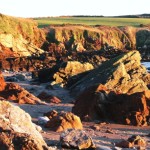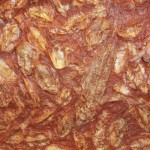The soils and rocks of the Sandy Haven area are a distinct pink/red colour. These rocks are called the Old Red Sandstone by geologists and they belong to the Devonian period – known as The Age of Fishes. The rocks are about 395 million years old. They can be seen to be mainly red shales but with intercalated layers of coarse sandstone and conglomerate. Many of the conglomerate beds are rich in white quartz pebbles that make up the pretty rocks used to build the top of the shell well. The red shales are believed to have been esturine mud banks and the conglomerates and sandstones were deposited in river channels crossing them. At the top of Lindsway Bay is a prominent large flat topped block of this Devonian rock (much sought after as a table by picnickers) which is made of very coarse grained rock fragments. These are composed of ancient fragments of volcanic lavas as well as white quartz. The ancient mainland behind the mud flats was evidently composed of these volcanic rocks cut by quartz veins. To geologists this is a rock combination likely to yield gold but this is not known. Recently at a small town called Wincanalea in New South Wales, Australia a world class fossil discovery was made. A layer of Old Red Sandstone was found to be crowded with thousands of fossil fish. There are two types. Smaller pteraspid fish up to 18 inches long have large headshields. Other scaley fish with short limbs are up to five feet long. This unique occurrence (and there is a lot more to be excavated) is believed to have formed when a large lagoon with many fish dried up, so the fish became concentrated in the last water, where their remains lie side by side.

